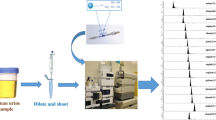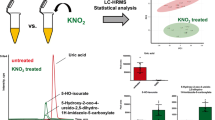Abstract
Analyzing the composition of (human) urine plays a major role in the fields of biology and medicine. Organic molecules (such as urea, creatine) and ions (such as chloride, sulfate) are the major compounds present in urine, the quantification of which allows for the diagnosis of a subject’s health condition. Various analytical methods have been reported for studying urine components and validated on the basis of known and referenced compounds. The present work introduces a new method able to simultaneously determine both major organic molecules and ions contained in urine, by combining ion chromatography using a conductimetric detector with mass spectroscopy. The analysis of organic and ionized compounds (anionic and cationic) was achieved in double injections. For quantification, the standard addition method was used. Human urine samples were pre-treated (diluted and filtered) for IC-CD/MS analysis. The analytes were separated in 35 min. Calibration ranges (0–20 mg.L−1) and correlation coefficients (> 99.3%) as well as detection (LODs < 0.75 mg.L−1) and quantification (LOQs < 2.59 mg.L−1) limits were obtained for the main organic molecules (lactic, hippuric, citric, uric, oxalic acids, urea, creatine, and creatinine) and ions (chloride, sulfate, phosphate, sodium, ammonium, potassium, calcium, and magnesium) contained in urine. The intra- and inter-day accuracies of the analytes consistently ranged from 0.1 to 5.0%, and the precision was within 4.0%. For all analytes, no significant matrix effects were observed, and recoveries ranged from 94.9 to 102.6%. Finally, quantitative results of analytes were obtained from 10 different human urine samples.
Graphical abstract




Similar content being viewed by others
Abbreviations
- DP:
-
Dual pump
- ESI:
-
Electrospray ionization
- HPLC:
-
High-performance liquid chromatography
- IC-CD/MS:
-
Ion chromatography–conductivity detector/mass spectroscopy
- ICH:
-
International Council for Harmonisation of Technical Requirements for Registration of Pharmaceuticals for Human Use
- LC:
-
Liquid chromatography
- LOD:
-
Limit of detection
- LOQ:
-
Limit of quantification
- ME:
-
Matrix effect
- RE:
-
Relative error
- RF:
-
Radio frequency
- RSD:
-
Relative standard deviation
- SD:
-
Standard deviation
- UHPLC:
-
Ultra-high-performance liquid chromatography
- a.u. :
-
Arbitrary unit
- B:
-
Magnetic field (T)
- K1 and K2 :
-
Calculated ratios to validate the human urine presence in a sample (dimensionless)
- \({~}^{\mathrm{m}}\!\left/ \!{~}_{\mathrm{z}}\right.\) :
-
Mass-to-charge ratio
- n :
-
Number of repetitions (dimensionless)
- N :
-
Size of the population
- Tr :
-
Retention time (min)
- R 2 :
-
Correlation coefficient (dimensionless)
- x i :
-
Each value from the population
- μ :
-
Population mean
References
Queremel Milani DA, Jialal I. Urinalysis. In: StatPearls [Internet]. Treasure Island (FL): StatPearls Publishing; 2023. Available from: https://www.ncbi.nlm.nih.gov/books/NBK557685/
Njoku K, Chiasserini D, Jones ER, Barr CE, O’Flynn H, Whetton AD, et al. Urinary biomarkers and their potential for the non-invasive detection of endometrial cancer. Front Oncol. 2020;3(10):559016.
Jing J, Gao Y. Urine biomarkers in the early stages of diseases: current status and perspective. Discov Med. 2018;25(136):57–65.
Sequeira-Antunes B, Ferreira HA. Urinary biomarkers and point-of-care urinalysis devices for early diagnosis and management of disease: a review. Biomedicines. 2023;11(4):1051.
Putnam DF. Composition and concentrative properties of human urine [Internet]. National Aeronautics and Space Administration; 1971. Available from: https://ntrs.nasa.gov/citations/19710023044. Accessed 20 June 2023
Bouatra S, Aziat F, Mandal R, Guo AC, Wilson MR, Knox C, et al. The human urine metabolome. Dzeja P, editor. Plos One. 2013;8(9):e73076.
Brunzel NA. Fundamentals of urine and body fluid analysis - e-book. 5th ed. Philadelphia: Elsevier; 2022.
Das Gupta B. Urine analysis [Internet]. Elsevier. India; 1932. 152 p. Available from: https://doi.org/10.1016/C2013-0-06676-5
Lopes D, Morés L, Da Silva M, Schneider M, Merib J, Carasek E. Determination of hormones in urine by hollow fiber microporous membrane liquid–liquid extraction associated with 96-well plate system and HPLC-FLD detection. J Chromatogr B. 2022;1207:123406.
Mohamed GG, Fekry AM, Attia FMA, Ibrahim NS, Azab SM. Simultaneous determination of some antidepressant drugs and vitamin B12 in pharmaceutical products and urine sample using HPLC method. J Chromatogr B. 2020;1150:122178.
Ashiru DAI, Patel R, Basit AW. Simple and universal HPLC-UV method to determine cimetidine, ranitidine, famotidine and nizatidine in urine: application to the analysis of ranitidine and its metabolites in human volunteers. J Chromatogr B. 2007;860(2):235–40.
Zoller A, Wehmeyer K, Krivos K, Karb M, Stoffolano P, Nash JF, et al. UHPLC-MS/HRMS method for the quantitation of pyrithione metabolites in human urine. J Chromatogr B. 2021;1173:122614.
Ma Q, Qi C, Li XL, Shi Q, Xu CY, Jin T, et al. Simultaneous determination of DL-cysteine, DL-homocysteine, and glutathione in saliva and urine by UHPLC-Q-Orbitrap HRMS: application to studies of oxidative stress. J Pharm Biomed Anal. 2021;196:113939.
Dmitrieva E, Temerdashev A, Azaryan A, Gashimova E. Quantification of steroid hormones in human urine by DLLME and UHPLC-HRMS detection. J Chromatogr B. 2020;1159:122390.
Coglianese A, Charlier B, Mensitieri F, Filippelli A, Izzo V, Dal Piaz F. Standard addition method (SAM) in LC-MS/MS to quantify gluten-derived metabolites in urine samples. J Pharm Biomed Anal. 2023;232:115416.
Young BL, Victoria ZY. A rapid dilute-and-shoot LC-MS/MS method for quantifying THC-COOH and THC-COO(Gluc) in urine. J Chromatogr B. 2022;1211:123495.
Reber JD, Karschner EL, Seither JZ, Knittel JL, Walterscheid JP. Screening and confirmation methods for the qualitative identification of nine phytocannabinoids in urine by LC-MS/MS. Clin Biochem. 2021;98:54–62.
Liu J, Lu W, Zhang L, Yang J, Yao ZP, He Y, et al. Integrated hand-held electrochemical sensor for multicomponent detection in urine. Biosens Bioelectron. 2021;193:113534.
Hu X, Takenaka N, Kitano M, Bandow H, Maeda Y, Hattori M. Determination of trace amounts of urea by using flow injection with chemiluminescence detection. The Analyst. 1994;119(8):1829.
Langenfeld NJ, Payne LE, Bugbee B. Colorimetric determination of urea using diacetyl monoxime with strong acids. Signore G, editor. Plos One. 2021;16(11):e0259760.
Teekayupak K, Aumnate C, Lomae A, Preechakasedkit P, Henry CS, Chailapakul O, et al. Portable smartphone integrated 3D-printed electrochemical sensor for nonenzymatic determination of creatinine in human urine. Talanta. 2023;254:124131.
Caporossi L, Paci E, Capanna S, Papaleo B, Tranfo G, Pigini D. A new HPLC-MS/MS method for urinary creatinine determination: comparison study with Jaffè’s method. URINE. 2023;5:23–8.
Musile G, Agard Y, Pesavento S, De Palo EF, Dorizzi RM, Bortolotti F. An origami microfluidic paper device for on-site assessment of urine tampering. First use of Nessler’s reagent for the colorimetric determination of creatinine. Anal Chim Acta. 2023;1237:340610.
Rocha DL, Rocha FRP. An environmentally friendly flow-based procedure with photo-induced oxidation for the spectrophotometric determination of chloride in urine and waters. Microchem J. 2013;108:193–7.
Zuo Y, Wang C, Zhou J, Sachdeva A, Ruelos VC. Simultaneous determination of creatinine and uric acid in human urine by high-performance liquid chromatography. Anal Sci. 2008;24(12):1589–92.
George SK, Dipu MT, Mehra UR, Singh P, Verma AK, Ramgaokar JS. Improved HPLC method for the simultaneous determination of allantoin, uric acid and creatinine in cattle urine. J Chromatogr B. 2006;832(1):134–7.
Kwon W, Kim JY, Suh S, In MK. Simultaneous determination of creatinine and uric acid in urine by liquid chromatography–tandem mass spectrometry with polarity switching electrospray ionization. Forensic Sci Int. 2012;221(1–3):57–64.
Sakurai T, Irii T, Iwadate K. Simultaneous quantification of urea, uric acid, and creatinine in human urine by liquid chromatography/mass spectrometry. Leg Med. 2022;55:102011.
Wang F, Liu Y, Zhang M, Zhang F, He P. Home detection technique for Na + and K + in urine using a self-calibrated all-solid-state ion-selective electrode array based on polystyrene–Au ion-sensing nanocomposites. Anal Chem. 2021;93(23):8318–25.
Ghaderinezhad F, Ceylan Koydemir H, Tseng D, Karinca D, Liang K, Ozcan A, et al. Sensing of electrolytes in urine using a miniaturized paper-based device. Sci Rep. 2020;10(1):13620.
Oginawati K, Anka AAH, Susetyo SH, Febriana SA, Tanziha I, Prakoeswa CRS. Urinary hippuric acid level as a biological indicator of toluene exposure on batik workers. Heliyon. 2021;7(8):e07775.
Gunst J, Kashani KB, Hermans G. The urea-creatinine ratio as a novel biomarker of critical illness-associated catabolism. Intensive Care Med. 2019;45(12):1813–5.
Wang X, Wang M, Ruan J, Zhao S, Xiao J, Tian Y. Identification of urine biomarkers for calcium-oxalate urolithiasis in adults based on UPLC-Q-TOF/MS. J Chromatogr B. 2019;1124:290–7.
Krupp D, Doberstein N, Shi L, Remer T. Hippuric acid in 24-hour urine collections is a potential biomarker for fruit and vegetable consumption in healthy children and adolescents. J Nutr. 2012;142(7):1314–20.
Xiang LW, Li J, Lin JM, Li HF. Determination of gouty arthritis’ biomarkers in human urine using reversed-phase high-performance liquid chromatography. J Pharm Anal. 2014;4(2):153–8.
Nikolaidis S, Karpouzi C, Tsalis G, Kabasakalis A, Papaioannou KG, Mougios V. Reliability of urine lactate as a novel biomarker of lactate production capacity in maximal swimming. Biomarkers. 2016;21(4):328–34.
ICH. Validation of analytical procedures: text and methodology Q2(R2). London, UK: EMA; 2022.
El Himri M, Errasfa M, El Kassimi A, Naboulsi A, El Himri A, El Haddad M. Method validation for arsenic speciation in contaminated soil by HPLC-ICP-MS coupling method. J Indian Chem Soc. 2022;99(10):100684.
Cho J, Lee J, Lim CU, Ahn J. Quantification of pesticides in food crops using QuEChERS approaches and GC-MS/MS. Food Addit Contam Part A. 2016;33(12):1803–16.
March RE, Todd JFJ, (Eds.). Practical aspects of trapped ion mass spectrometry, Volume IV: Theory and Instrumentation (1st ed.). CRC Press. 2010. https://doi.org/10.1201/9781420083729
Huang Y, Mou S, fen, Liu K na. Conductimetric detection of anions of very weak acids by incomplete suppressed ion chromatography. J Chromatogr A. 1999;832(1–2):141–8.
Unak P, Darcan Ş, Yurt F, Biber Z, Çoker M. Determination of iodide amounts in urine and water by isotope dilution analysis. Biol Trace Elem Res. 1999;71–72(1):463–70.
Sato K, Tsutsumi H, Htay HH, Tamaki K, Okajima H, Katsumata Y. Identification of human urinary stains by the quotient uric acid/urea nitrogen. Forensic Sci Int. 1990;45(1–2):27–38.
Fujishiro M, Sobue H, Taira R, Ohtawa T, Umezawa H, Izawa H, et al. Identification of human urinary stains by the uric acid/creatinine quotient and HPLC chromatogram. J Showa Med Assoc. 2008;68(3):175–81.
Acknowledgements
The authors would like to thank the volunteers for their urine donations.
Funding
This work was supported by the French National Research Agency (proposal HYUREA ANR-19-CE04-0009).
Author information
Authors and Affiliations
Contributions
Guillaume Hopsort: conceptualization; methodology; validation; formal analysis; investigation; data curation; writing - original draft; and visualization. Laure Latapie: conceptualization; methodology; validation; formal analysis; investigation; resources; writing - review and editing; and funding acquisition. Karine Groenen Serrano: writing - review and editing, and supervision. Karine Loubière: writing - review and editing, and supervision. Théodore Tzedakis: writing - review and editing; supervision; project administration; and funding acquisition.
Corresponding authors
Ethics declarations
Ethical approval
This is an observational study; no ethical approval was needed for the study. Before gathering any information, we ensured to obtain written approvals from each participant with notice of information and consent form. All procedures performed in studies involving human participants were in accordance with the ethical standards of the institutional and/or national research committee and with the 1964 Helsinki Declaration and its later amendments. This study was conducted with healthy individuals aged 18 and above, who had no previous record of kidney-related ailments. The study excluded those who were currently suffering from a urinary tract infection. Furthermore, female participants were instructed to undertake the test on non-menstrual days.
Conflict of interest
The authors declare no competing interests.
Additional information
Publisher’s note
Springer Nature remains neutral with regard to jurisdictional claims in published maps and institutional affiliations.
Supplementary information
ESM 1
(DOCX 1.30 mb)
Rights and permissions
Springer Nature or its licensor (e.g. a society or other partner) holds exclusive rights to this article under a publishing agreement with the author(s) or other rightsholder(s); author self-archiving of the accepted manuscript version of this article is solely governed by the terms of such publishing agreement and applicable law.
About this article
Cite this article
Hopsort, G., Latapie, L., Groenen Serrano, K. et al. Deciphering the human urine matrix: a new approach to simultaneously quantify the main ions and organic compounds by ion chromatography/mass spectrometry (IC-MS). Anal Bioanal Chem 415, 5337–5352 (2023). https://doi.org/10.1007/s00216-023-04808-2
Received:
Revised:
Accepted:
Published:
Issue Date:
DOI: https://doi.org/10.1007/s00216-023-04808-2




